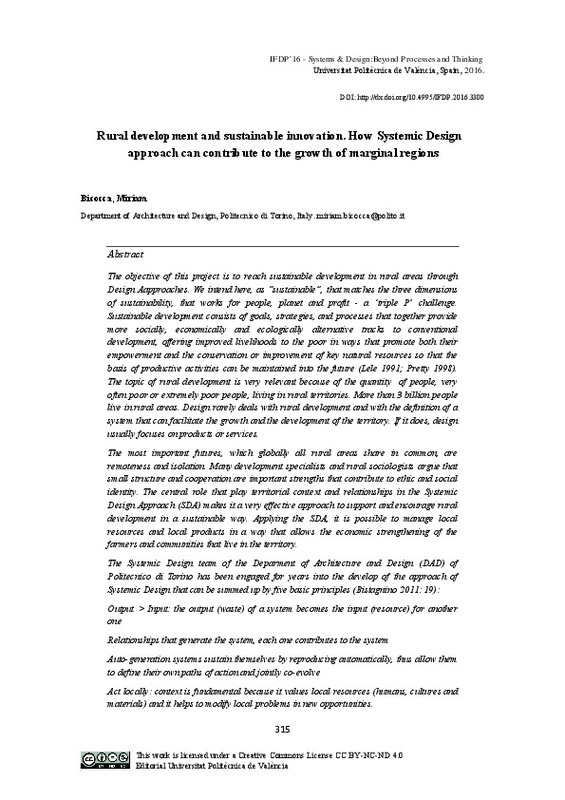|
Resumen:
|
[EN] The objective of this project is to reach sustainable development in rural areas through
Design Aapproaches. We intend here, as “sustainable”, that matches the three dimensions
of sustainability, that works for ...[+]
[EN] The objective of this project is to reach sustainable development in rural areas through
Design Aapproaches. We intend here, as “sustainable”, that matches the three dimensions
of sustainability, that works for people, planet and profit - a ‘triple P’ challenge.
Sustainable development consists of goals, strategies, and processes that together provide
more socially, economically and ecologically alternative tracks to conventional
development, offering improved livelihoods to the poor in ways that promote both their
empowerment and the conservation or improvement of key natural resources so that the
basis of productive activities can be maintained into the future (Lele 1991; Pretty 1998).
The topic of rural development is very relevant becouse of the quantity of people, very
often poor or extremely poor people, living in rural territories. More than 3 billion people
live in rural areas. Design rarely deals with rural development and with the definition of a
system that can facilitate the growth and the development of the territory. If it does, design
usually focuses on products or services.
The most important futures, which globally all rural areas share in common, are
remoteness and isolation. Many development specialists and rural sociologists argue that
small structure and cooperation are important strengths that contribute to ethic and social
identity. The central role that play territorial context and relationships in the Systemic
Design Approach (SDA) makes it a very effective approach to support and encourage rural
development in a sustainable way. Applying the SDA, it is possible to manage local
resources and local products in a way that allows the economic strengthening of the
farmers and communities that live in the territory.
The Systemic Design team of the Deparment of Architecture and Design (DAD) of
Politecnico di Torino has been engaged for years into the develop of the approach of
Systemic Design that can be summed up by five basic principles (Bistagnino 2011: 19):
Output > Input: the output (waste) of a system becomes the input (resource) for another
one
Relationships that generate the system, each one contributes to the system
Auto-generation systems sustain themselves by reproducing automatically, thus allow them
to define their own paths of action and jointly co-evolve
Act locally: context is fundamental because it values local resources (humans, cultures and
materials) and it helps to modify local problems in new opportunities.
Man at the centre of the project: Man is connected to own environmental, social, cultural
and ethic context.
It is essential to start from the current state of the art, that allows to define strengths and
weaknesses, before to design the system, made of flows between actors.
[-]
|








